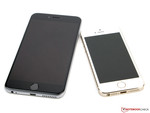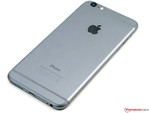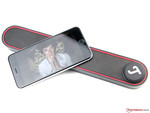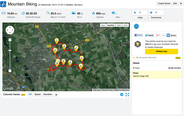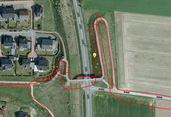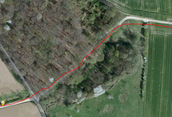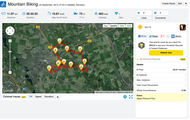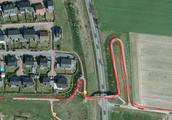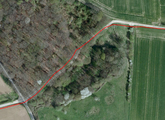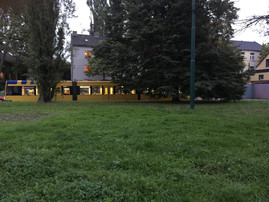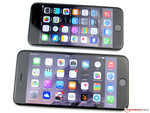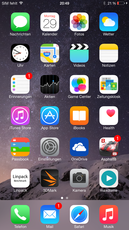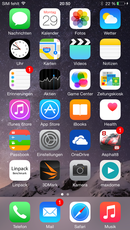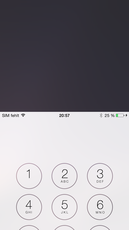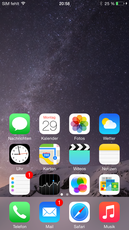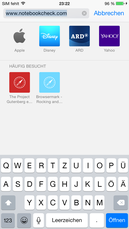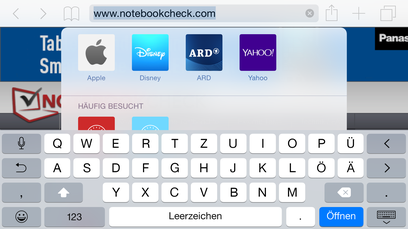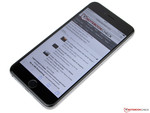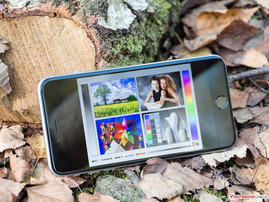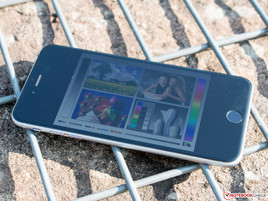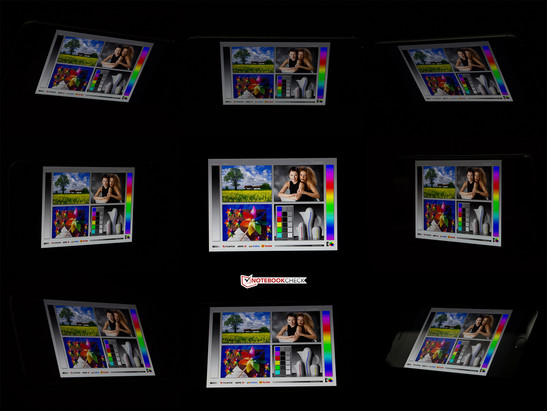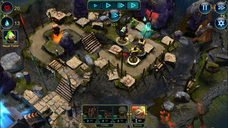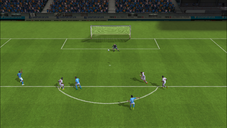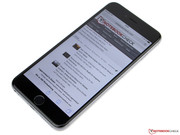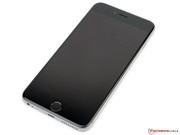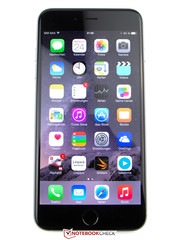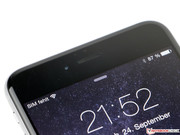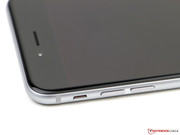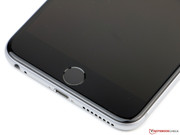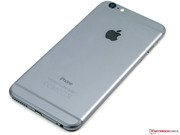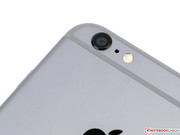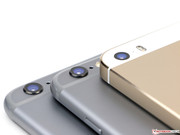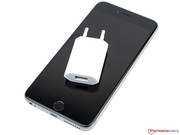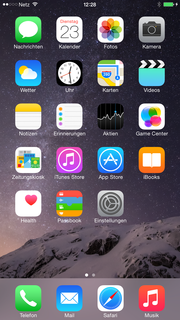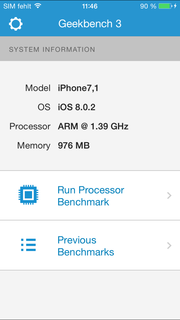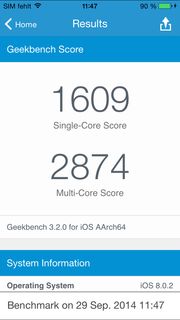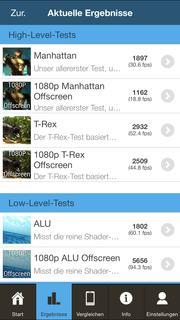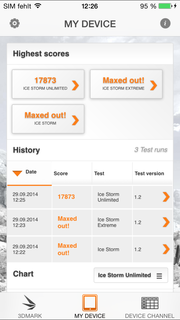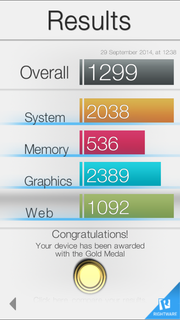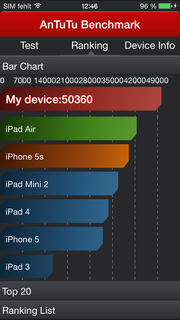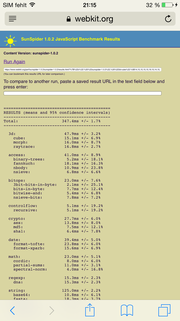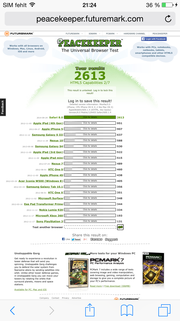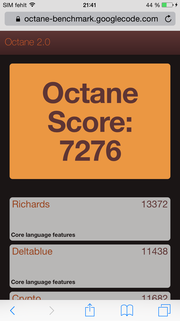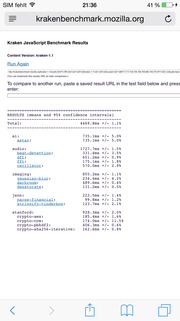Apple iPhone 6 Plus Smartphone Review

For the original German review, see here.
The new iPhone not only attracted attention with new sales records, but also with its unintentionally flexible characteristics. It looks just like its smaller sibling iPhone 6 if it was not for the striking size difference. The iPhone 6 Plus is equipped with the Apple A8 processor as well, but it is supposed to run slightly faster than the smaller version. Apple has integrated an optical image stabilizer into the camera, while the smaller version uses an electrical one. You also get three storage configurations with 16, 64 and 128 GB. The iPhone 6 Plus retails for 799 Euros (~$1000) in the smallest configuration and is therefore 100 Euros (~$125) more expensive than the normal iPhone 6. Every storage upgrade costs an extra 100 Euros (~$125), so the 128 GB has an enormous price tag of 999 Euros (~$1250). Our review unit is the 64 GB version. We did not get a review sample from the manufacturer this time, either, but we bought it instead.
The competition does not really differ from the smaller iPhone. However, besides the Samsung Galaxy S5 (5.1-inch, starting at 460 Euros; ~$576), HTC One M8 (5.0-inch, starting at 530 Euros; ~$663), Sony Xperia Z3 (5.2-inch, starting at 650 Euros; ~$814), LG G3 (5.5-inch, starting at 440 Euros; ~$550) and the Lumia 930 (5.0-inch, starting at 480 Euros; ~$600), the list also includes larger high-end smartphones like the Samsung Galaxy Note 3 (5.7-inch, starting at 340 Euros; ~$425), Huawei Ascend Mate 7 (6.0-inch, RRP of 499 Euros; ~$625) and the Nokia Lumia 1520 (6.0-inch, starting at 380 Euros; ~$475). Both the Samsung Galaxy Note 4 (5.7 inches) and Galaxy Edge (5.6 inches) will be available shortly.
Case
Like the smaller model, the Apple iPhone 6 Plus is made of aluminum and glass. It leaves a very sophisticated impression and the overhauled design looks pleasing. With a height of 7.1 millimeters (0.28 inches) and a weight of 172 grams (0.38 lb) it is not too heavy, but there are thinner smartphones with similarly sized displays on the market, and the camera lens is protruding by half a millimeter from the case as well. Anyone that has ever held the LG G3 (149 g; ~0.33 lbs, 8.95 mm; ~0.35 inches) will think that the iPhone 6 Plus is bulky.
The big topic about the iPhone 6 Plus is Bendgate. The smartphone supposedly bends when you wear it in the pocket of your pants. We can confirm this. We noticed a slight deformation when we put it on a table after one hour in our pocket. It was not completely flat anymore and it wobbled around a bit. However, the problem was gone on the next day. Because of the very thin aluminum alloy and the large surface, it is potentially more vulnerable than the iPhone 6. One weakness area is around the volume rocker, where it bends and even cracks under a lot of force, and this has been confirmed by our colleagues from Unbox Therapy. Consumerreports.org also took a closer look at the torsion resistance. Anyway, Bendgate is a phenomenon that should not happen when you buy a smartphone that can cost almost 1,000 Euros (~$1250).
Some attempts show that you can actually move the metal when you twist it quite forcefully and there are some creaking sounds from the iPhone 6 Plus. Strong pressure on the back also results in minimal waves on the display. The larger version is not as good as the smaller original in this area, there is still room for improvements. The gaps on the other hand, are without criticism and very even.
Once again, you cannot expand the storage or replace the battery of the iPhone 6 Plus. It is also available in the colors silver, space gray and gold. Our colleagues from iFixit checked the maintainability of the smartphone as well and the result is similar to the iPhone 6. It can get 7 out of 10 points, which is a good result. All in all, the build quality leaves mixed impressions. You get high-quality materials, but there are drawbacks with regard to the stability
Connectivity
Basically, the connectivity of the Apple iPhone 6 Plus has not changed. The only physical connector is the Lightning port, which can be used to connect the smartphone with a computer or charge the battery. You can also spend some money on suitable adaptors so you can use the port for video transfers (HDMI or VGA), or use it as a card reader. NFC is finally available, but currently the interface can only be used for the payment service, Apple Pay. Wireless transfers of media files are only possible via AirPlay. DLNA is not supported.
Software
The software of the Apple iPhone 6 Plus is similar to the iPhone 6, a detailed report is available in the review of the sibling. Apple released iOS 8.0.2 after iOS 8.0.1 was a failure that was quickly withdrawn.
A detailed list of improvements is not available, but the overall system now runs smoother. Unfortunately, some apps still seem to have problems despite some updates. We noticed problems and heavy delays in Dropbox and Outbank 2. Version 5.0.1 of AnTuTu on the other hand runs without any problems now.
Still, the new version of iOS introduces new issues. If the smartphone is restored to factory settings, the cloud data of some apps will be deleted.
Communication & GPS
The Apple iPhone 6 Plus also uses a WLAN module, which supports the IEEE-802.11 standards a/b/g/n/ac. The component works both in 2.4 as well as 5 GHz networks. The range is decent as well and is similar to the iPhone 6. Even with a distance of around 20 meters (~66 ft) from the router (Fritz!Box 6360, 2.4 GHz network) we determined ping times under 15 ms and the device still indicated a good signal quality. We noticed some slight delays when we opened a website in Safari, but the content was quickly loaded. There were no WLAN dropouts under iOS 8.0.2 during our review.
As well as HSPA+ with support for download speeds of up to 42 Mbps, mobile Internet connections can be established via LTE Cat.4. The fast standard supports up to 150 Mbps for downloads and 50 Mbps for uploads. Unfortunately, this does not represent the latest technology, some of the new high-end Android devices already support LTE Cat. 6, which enables download speeds of up to 300 Mbps. On the other hand, the iPhone covers a wide range of frequencies, so you should be able to use it almost anywhere in the world.
Bluetooth 4.0 LE is available on the iPhone 6 Plus, but once again, you will have to forgo the newer 4.1 standard. Still, the interface works well, and streams music and videos without any problems. Something that is still an issue under iOS 8.0.2 is the connection with some car hands-free solutions including VW and BMW, which we have already described in the iPhone 6 review.
Compared to the smaller version, the review unit locates our position much more quickly and works very accurately. This is the advantage of the larger case, there is space for more powerful antennas. The satellite fix is very quick and reliable, both outdoors and even indoors.
Compared to the bicycle computer Garmin Edge 500, the iPhone 6 Plus is even better. Even complex sections of the track, for example, the areas around the crossing or the drive through the forest, are no problem for the smartphone.
Telephone Functions and Voice Quality
The phone app of the iPhone 6 Plus is clear as usual and allows quick access to the list of calls and contacts, even though it can be tricky to operate the device with one hand. Hold the phone against your ear, and both sides of the call can enjoy very good voice quality. However, the device could be improved in terms of background noise reduction. The music in the background was just partially filtered and was occasionally audible. Making a call via speaker is comparatively good, but the voice of the iPhone user sounds slightly muffled. The provided headphones leave a mixed impression. While they work well as a microphone, they put a lot of emphasis on the bass, which sounds strange when you make a call. High tones are also very distorted, so they are pretty shrill.
Cameras
The Apple iPhone 6 Plus uses the same front camera as the iPhone 6 with a 1.2 MP sensor (1,280x960 pixels, 4:3) that takes bright pictures, but they are pretty blurry. It is adequate for video calls, but not really suitable for pictures.
The main camera at the back of the smartphone is very similar to the smaller version as well with an 8 MP sensor (3,264x2,448 pixels, 4:3). Instead of an electronic image stabilizer, the iPhone 6 Plus uses an optical one. The results once again appear brighter and with a higher contrast compared to the iPhone 5s, and there is no criticism in terms of sharpness, either. Results in daylight can look great, the HDR mode does excellent work.
The autofocus with Focus Pixels works quickly and accurately in this case as well. However, the autofocus occasionally has some issues in darker environments and it takes a couple of attempts, which can result in push effects. The pictures also quickly lose quality in low-light situations and you can see picture noise, details sometimes appear blurry.
The first time when you really notice the optical image stabilizer is when you take panoramas. The results are much sharper and clearer. It still requires some skill, but small wobbles do not affect the picture as much as they do on the iPhone 6.
We took a closer look at the optical image stabilizer of the iPhone 6 Plus. It is not only supposed to improve pictures with higher exposure times, but also takes smoother videos. The OIS (Optical Image Stabilizer) does have a positive effect on pictures. Details stay sharper and the pictures just appear better in their original size.
However, the impression of the OIS is mixed during video recordings. We used the review unit and the iPhone 6 together in one tripod and fixed it on a bike to ensure a better assessment of the components. The ride on a gravel road in the park should result in visible differences, and this is actually the case. While the electronic image stabilizer of the iPhone 6 only allowed small wobbles and recorded a convincing result, the iPhone 6 Plus failed completely. Immediately after the start we can clearly see waves in the picture, and another run with only the review unit in the tripod did not change the situation. The problem here is certainly the OIS, which does not recognize that the smartphone is on a tripod. Therefore, the system tries to compensate the movements that are not there, which results in an opposite effect. Good OIS systems recognize when they are being used on a tripod, and deactivate themselves. We would have at least liked to see an option to deactivate the OIS manually. The OIS works very well if you hold the smartphone in your hands and the results look great. But the problem does not only affect videos, pictures that are taken with a tripod are affected as well. However, you only have to live with slightly blurry pictures in this case. You can hardly notice the issues of the OIS in time-lapse or slow-motion recordings.
The video and sound quality is identical to the iPhone 6. More information is available in its review.
Accessories
The accessories included with the Apple iPhone 6 Plus, are a modular power adaptor with a rated output of 5 Watts (5 V, 1 A), a Lightning cable as well as a headset.
There are many optional accessories in the web store of the Californian company, starting with cases or better headphones up to professional audio interfaces.
Warranty
Apple offers a warranty of 12 months for the iPhone 6 Plus, which includes phone support for the first 90 days.
The warranty extension Apple Care+ (99 Euros; ~$124) expands the warranty period to 24 months and has to be bought within 60 days of the purchase of the smartphone. It also covers up to two accidental damages for an additional service fee of 69 Euros (~$86) for each repair.
Input Devices & Handling
The capacitive touchscreen of the Apple iPhone 6 Plus works very well. Inputs are easily recognized and executed even into the peripheral areas. The gliding capabilities of the glass surface are also really good and do not give cause for criticism. You can still see fingerprints, but the panel is comparatively easy to clean.
The virtual keyboard of the smartphone is similar to the iPhone 6, it is only slightly larger, which slightly improves the handling. You get two additional columns with additional functions in landscape mode. QuickType is available here as well and suggests words in an additional row. The feature works quite well, but it is nothing new if you already have a smartphone with Android or Windows Phone.
One small drawback is the size of the touchscreen if you just want to operate the iPhone 6 Plus with one hand. In this case it is very hard to operate the whole display with the thumbs, despite the so called Reachability mode for a one-handed operation. It can be activated with a double tap on the Home button and reduces the content to half of the display, but some fingers will still have a problem to reach the opposite side of the panel. Other manufacturers offer much more comfortable solutions.
Touch ID is once again integrated into the Home button and recognizes fingerprints very reliably.
Display
The Apple iPhone 6 Plus has a 5.5-inch IPS display with a resolution of 1,920x1,080 pixels (Full HD) and an aspect ratio of 16:9. This results in a pixel density of around 401 ppi, higher values are only provided by the LG G3 (534 ppi), which is the only device within this comparison with a WQHD screen. All the other rivals have the same number of pixels, but larger display sizes.
Our review unit is also unrivaled in terms of luminance. It manages up to 519 cd/m² and the brightness distribution is very good as well with 90 percent. Only the HTC One Max (up to 463 cd/m², 95%) is superior in the latter discipline. We could not notice any screen bleeding on the display of the iPhone 6 Plus.
| |||||||||||||||||||||||||
Brightness Distribution: 90 %
Center on Battery: 519 cd/m²
Contrast: 837:1 (Black: 0.62 cd/m²)
ΔE ColorChecker Calman: 3.67 | ∀{0.5-29.43 Ø4.77}
ΔE Greyscale Calman: 3.78 | ∀{0.09-98 Ø5}
Gamma: 2.42
CCT: 7327 K
| Apple iPhone 6 Plus PowerVR GX6450, A8, 64 GB eMMC Flash | Samsung Galaxy Note 3 SM-N9005 Adreno 330, 800 MSM8974, 32 GB SSD | LG G3 Adreno 330, 801 MSM8974AC, 16 GB eMMC Flash | HTC One Max Adreno 320, 600 APQ8064T, 16 GB iNAND Flash | Nokia Lumia 1520 Adreno 330, 800 MSM8974, 32 GB eMMC Flash | |
|---|---|---|---|---|---|
| Screen | |||||
| Brightness middle (cd/m²) | 519 | 335 -35% | 417 -20% | 445 -14% | 421 -19% |
| Brightness (cd/m²) | 496 | 342 -31% | 395 -20% | 450 -9% | 399 -20% |
| Brightness Distribution (%) | 90 | 81 -10% | 89 -1% | 95 6% | 86 -4% |
| Black Level * (cd/m²) | 0.62 | 0.1 84% | 0.96 -55% | 0.43 31% | 0.48 23% |
| Contrast (:1) | 837 | 3350 300% | 434 -48% | 1035 24% | 877 5% |
| Colorchecker dE 2000 * | 3.67 | 6.14 -67% | 5.67 -54% | 4.89 -33% | 3.28 11% |
| Greyscale dE 2000 * | 3.78 | 5.27 -39% | 5.66 -50% | 4.82 -28% | 2.28 40% |
| Gamma | 2.42 91% | 2.39 92% | 2.53 87% | 2.41 91% | 2.5 88% |
| CCT | 7327 89% | 7559 86% | 7741 84% | 7140 91% | 6936 94% |
| Color Space (Percent of AdobeRGB 1998) (%) | 59 |
* ... smaller is better
The black value of 0.62 cd/m² is slightly high, but the contrast ratio of 837:1 is pretty good. Still, some of the rivals with LCD panels manage better results, especially the One Max (SLCD3, 0.43 cd/m², 1,035:1) and the Lumia 1520 (IPS, 0.48 cd/m², 877:1). The Galaxy Note 3 is ahead of any competitor in this discipline due to the OLED technology anyway.
We can also see very good results for the iPhone 6 Plus in terms of color presentation, and it is also the only device within the comparison that covers the whole sRGB color space. The deviations in the ColorChecker (dE 3.7) and the grayscale (dE 3.8) are minimal. However, we can see a slight shift towards blue in the saturation sweeps and color management. This results in a slight blue cast of the panel, but it is not visible in everyday use. Only the Lumia 1520 performs even better by allowing the user to regulate the color temperature of the panel. All things considered, Apple equips the iPhone 6 Plus with a great display.
The IPS display of the Apple iPhone 6 Plus is very convenient outdoors. It offers a good combination of powerful luminance and high contrast ratio. The reflections on the glass surface are limited, you can even see the display content under light sunlight.
Apple uses the so-called Dual-Domain pixels for the iPhone 6 Plus, which are supposed to ensure a better viewing angle stability of the IPS display. There is actually no problem with the picture quality, even with very flat viewing angles. Colors are unchanged and there is no brightness reduction. A good performance of the review unit, which is on a level with its smaller sibling.
Performance
Apple also uses the Apple A8 processor for the iPhone 6 Plus, which is supported by a Motion M8 coprocessor. The latter only handles the processing of sensor data. The manufacturer does not specify the clock of the dual-core processor. However, the tools Geekbench 3 and other benchmarks show that the processor runs with 1,390 MHz and therefore 40 MHz more than its counterpart inside the iPhone 6. Contrary to many speculations, even the larger iPhone is only equipped with 1 GB memory. Graphics are handled by the Imagination PowerVR GX6450.
Our review unit is neck and neck with the smaller version in the benchmarks. The per MHz performance of the processor is really great and shows that a dual-core CPU is completely sufficient in combination with an optimized operating system. Only the Samsung Galaxy S5, despite twice the number of cores, is currently able to keep up with the Apple CPU in the Geekbench 3 Multi-Core test. However, we expect this will change with the upcoming Snapdragon 805, which should be available in some devices this month. Only the K1 inside the NVIDIA Shield tablet is already faster as it can utilize all cores. Our review unit is sometimes slower than the iPhone 6, which could be caused by apps that do not support the native display resolution, so the iPhone 6 Plus has to scale the content.
It is a similar situation when we look at the GPU performance; the iPhone 6 Plus can easily beat the competitors. Only 3DMark Unlimited shows better results for the Galaxy S5, the Sony Xperia Z2 and the NVIDIA Shield. The reason for this is the better multi-core support, which results in better Physics-scores. The integrated GPU is otherwise up to date, only OpenGL ES 3 is not supported.
| GFXBench 3.0 | |
| on screen Manhattan Onscreen OGL (sort by value) | |
| Apple iPhone 6 Plus | |
| Samsung Galaxy Note 3 Neo N7505 | |
| Sony Xperia Z2 | |
| LG G3 | |
| Samsung Galaxy S5 | |
| HTC One M8 | |
| Apple iPhone 6 | |
| NVIDIA Shield Tablet P1761W | |
| 1920x1080 1080p Manhattan Offscreen (sort by value) | |
| Apple iPhone 6 Plus | |
| Samsung Galaxy Note 3 Neo N7505 | |
| Sony Xperia Z2 | |
| LG G3 | |
| Samsung Galaxy S5 | |
| HTC One M8 | |
| Apple iPhone 6 | |
| NVIDIA Shield Tablet P1761W | |
Apple is unrivaled in terms of browser performance and the iPhone 6 Plus manages excellent results in this area. Web browsing is very fast and the benchmarks confirm the subjectively high performance. Our review unit dominates the competition and can even manage a lead over the iPhone 6, however, this could be the result of the newer iOS version. Only Browsermark 2.1 had some issues, it just refused to finish and crashed continuously just to start all over again. We were not able to determine a result.
* ... smaller is better
The Apple iPhone 6 Plus is also available in three storage configurations with 16, 64 and 128 GB. The storage cannot be expanded and can only be complemented by cloud storage. All users get 5 GB iCloud storage for free. Our review unit is the 64 GB version. This value is shown in the decimal system, so you really get 59.6 GB with 55 GB for the user. The other 5 GB are required by the operating system and the preloaded apps. This means you should be able to use 10 and 114 GB for the 16 and 128 GB versions, respectively.
The performance is pretty fast compared to the Android rivals. Only the Note 3 has a clear advantage in Passmark. The Lumia 930 has the best storage result in the benchmark Basemark OS II.
| BaseMark OS II - Memory (sort by value) | |
| Apple iPhone 6 Plus | |
| Nokia Lumia 930 | |
| Nokia Lumia 1520 | |
| LG G3 | |
| Apple iPhone 5S | |
| Apple iPhone 6 | |
Gaming Performance
The enormous performance of the Imagination PowerVR GX6450 GPU inside the iPhone 6 Plus is more than sufficient for all games in the Apple App Store. Apple introduced its own graphics interface with iOS called Metal. The App Store has its own section with titles that already use the new interface. However, the reference title Vain Glory is not yet available and should be released in October, but it already looks very promising.
The touchscreen and the sensors work well and enable a nice gaming experience on the iPhone 6 Plus, which is a good choice for gaming because of its large display.
Emissions
Temperature
We can measure up to 36.4 °C (~97.52 °F) for the Apple iPhone 6 while idling. This is a pretty high result compared to the rivals, which are usually around 30 °C (~86 °F). Only the LG G3 (up to 39 °C; ~102.2 °F) gets warmer in this scenario.
We used the Relative Benchmark for more than one hour to determine the temperatures under continuous load. The device reached a maximum temperature of up to 41.7 °C (~107.06 °F), which is pretty warm but not alarming by any means. The coolest device is the HTC One Max (up to 35.5 °C; ~95.9 °F), while the Lumia 1520 (up to 49 °C; ~120.2 °F) gets much hotter. The review unit can take advantage of the larger surface for a more even temperature distribution compared to the iPhone 6 (up to 43.6 °C; ~110.48 °F).
It is always interesting to see whether the processor and the GPU can maintain their performance under continuous load. We check the behavior with the GFXBench 3.0 battery test. During the process, it runs the T-REX Onscreen test thirty times to determine a score. The tool not only records the power consumption, but also the frame rates. The result is convincing, the iPhone 6 can maintain a constant performance during the whole benchmark.
(±) The maximum temperature on the upper side is 41.7 °C / 107 F, compared to the average of 35.2 °C / 95 F, ranging from 21.9 to 247 °C for the class Smartphone.
(±) The bottom heats up to a maximum of 40 °C / 104 F, compared to the average of 34 °C / 93 F
(±) In idle usage, the average temperature for the upper side is 32.4 °C / 90 F, compared to the device average of 32.9 °C / 91 F.
Speakers
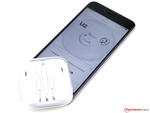
The mono speaker of the iPhone 6 Plus is located at the bottom and is slightly wider than the module of the iPhone 6. Medium tones and bass are perceptible, even though the latter cannot be felt. However, the high tones sound a bit muffled and the quality quickly decreases when you crank up the volume. The sound is tinny, overmodulated and slightly distorted.
The sound quality of the provided headphones is quite decent, but focused on bass. The EarPods belong to the better-quality accessories on the market, but they would not be adequate for music enthusiasts.
Energy Management
Power Consumption
You can easily compare the display power consumption of the iPhone 6 Plus when idling. We can measure a pretty high value of 2.5 Watts with the maximum brightness. The most frugal device is the Note 3 with its OLED panel (up to 1.4 Watts), only the high-resolution LG G3 (up to 2.3 Watts) is on a similar level.
We simulate the maximum load with the Relative Benchmark and measured a consumption of up to 5.8 Watts for our review unit. This is not a very high value when you consider the high performance of the SoC. We can record the highest value for the LG G3 (up to 9.1 Watts), but the Note 3 (up to 6.5 Watts) as well as the Lumia 1520 (up to 6.8 Watts) consume more power. Only the Snapdragon 600 of the One Max (up to 5.3 Watts) is more frugal, but the performance is not even close, either.
Apple equips the iPhone 6 plus with the same power adaptor (5 W, 5 V, 1 A) that we already know from the iPhone 6. It was already pretty weak for the smaller version, but the situation is even worse here. We would have liked to see the power adaptor of the iPads with a nominal output of 12 Watts, so the charging time could have been reduced. This way you will have to wait for more than four hours before the battery is completely recharged.
| Off / Standby | |
| Idle | |
| Load |
|
Key:
min: | |
Battery Runtime
The battery capacity of the Apple iPhone 6 Plus is much larger compared to the iPhone 6 with 2,915 mAh (11.1 Watts). As expected, the runtimes of the smartphone are significantly longer. We determine the maximum runtime with the minimum display brightness and deactivated communication modules, only the WLAN connection is active. A browser script simulates the reading of a book, and the result was almost a whole day. A very good result for the review unit. The other extreme scenario runs with all communication modules activated and the highest display brightness, while the Relative Benchmark is supposed to drain the battery as quickly as possible. The iPhone 6 Plus turned off after little more than three hours. Other devices manage better results.
We are surprised to see that the runtime in our WLAN test with an adjusted brightness (150 cd/m²) surpasses the runtime during video playback. It is usually the other way around, but another run of the video test did not show any changes but a similar result. However, both are great results.
| Apple iPhone 6 Plus PowerVR GX6450, A8, 64 GB eMMC Flash | HTC One Max Adreno 320, 600 APQ8064T, 16 GB iNAND Flash | Samsung Galaxy Note 3 SM-N9005 Adreno 330, 800 MSM8974, 32 GB SSD | Nokia Lumia 1520 Adreno 330, 800 MSM8974, 32 GB eMMC Flash | LG G3 Adreno 330, 801 MSM8974AC, 16 GB eMMC Flash | |
|---|---|---|---|---|---|
| Battery runtime | 24% | 32% | 1% | -34% | |
| Reader / Idle (h) | 23.9 | 25.7 8% | 36.6 53% | 24.3 2% | 14.2 -41% |
| H.264 (h) | 11.3 | 14.6 29% | 4.6 -59% | ||
| WiFi (h) | 13 | 14.1 8% | 18 38% | 9.7 -25% | 7.5 -42% |
| Load (h) | 3.3 | 5.1 55% | 3.5 6% | 3.2 -3% | 3.5 6% |
Verdict
It is unusually big, but still an iPhone. We miss the familiar perfection of Apple in the case of the iPhone 6 Plus. The poor stability of the case is just one issue. You should not be able to twist the case when you buy a device that can cost up to 1,000 Euros (~$1250). It seems the quality management of Apple did slip, so we do not award any points in the section Stability of the rating for the chassis. You are better off with an LG G Flex if you want to carry your smartphone around in your pocket.
iOS is still not completely smooth in version 8.0.2. Many issues are not fixed yet, apps do not run as they should, and new problems like the deletion of iCloud data were added. The ongoing problems with hands-free solutions via Bluetooth will be a problem if you are often on the road. The optical image stabilizer is also a problem if you want to use a tripod. It is just not possible to use the iPhone 6 Plus with one hand. Many competitors offer better solutions, but the Californians were not able to ensure a decent handling. All those points result in another point deduction since neither the concept, nor the software appear very sophisticated.
However, Apple does a good job in many regards as well. The display is really good and it is one of the best LCD screens you can currently get. The new A8 SoC and the PowerVR GX6450 are very fast and offer a whole lot of performance. Our review unit still manages very good battery runtimes in most scenarios. Finally, the GPS module is one of the best that is currently available in a smartphone.
We can recommend the device if you use a special case for the smartphone, do not intend to use the camera with a tripod, do not have a Bluetooth hands-free device, and have a lot of patience until Apple fixed all issues in iOS 8. Otherwise, there are many alternatives on the market, and they are also less expensive.


